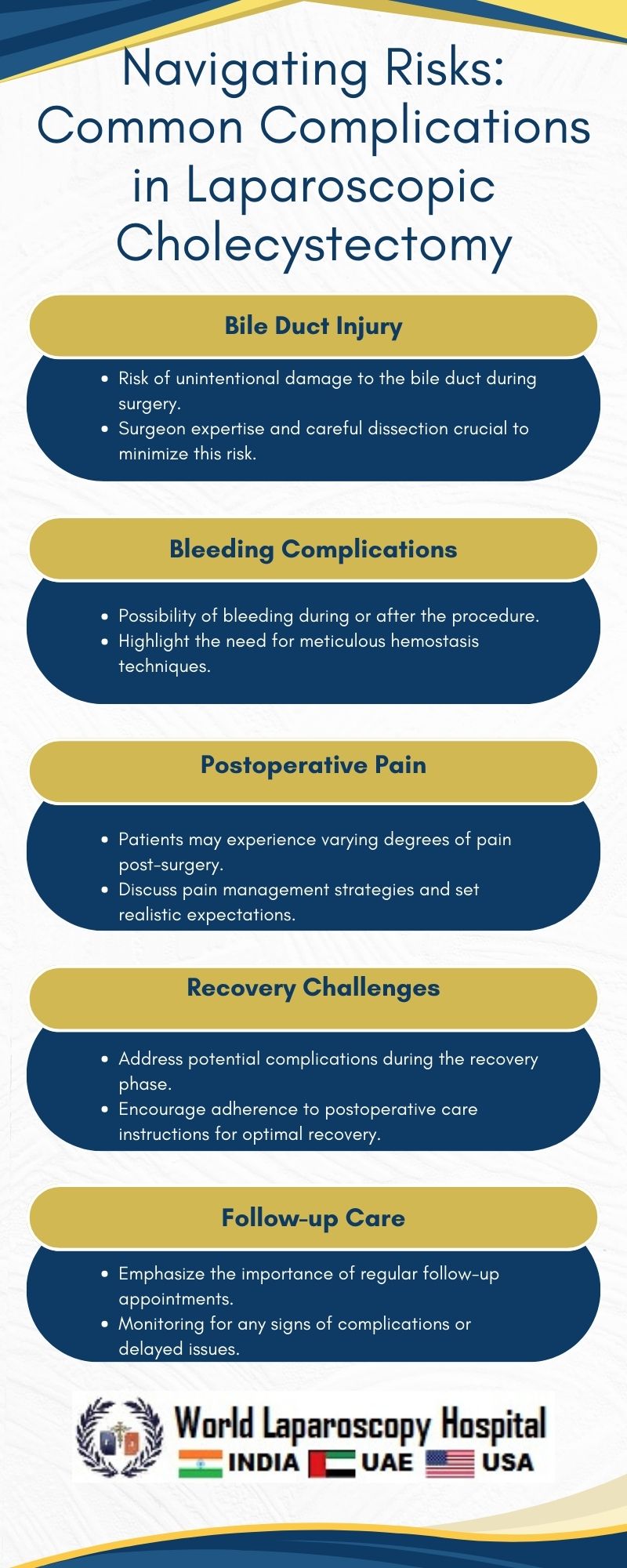Navigating Risks: Common Complications in Laparoscopic Cholecystectomy
Introduction
Laparoscopic cholecystectomy, a minimally invasive surgical procedure to remove the gallbladder, has revolutionized the field of surgery since its introduction in the late 1980s. This technique, often hailed for its shorter recovery times and reduced postoperative pain, has become the gold standard for gallbladder removal. However, like any surgical procedure, laparoscopic cholecystectomy is not without its share of risks and complications. In this comprehensive exploration, we delve into the common complications associated with laparoscopic cholecystectomy, shedding light on the challenges surgeons and patients may face during and after the surgery.

Understanding Laparoscopic Cholecystectomy
Laparoscopic cholecystectomy involves making small incisions in the abdomen to insert a camera (laparoscope) and specialized instruments, allowing surgeons to visualize and remove the gallbladder. The benefits of this approach include reduced pain, shorter hospital stays, and quicker recovery compared to traditional open surgery. Despite these advantages, surgeons must navigate various potential complications inherent to the procedure.
Bile Duct InjuryOne of the most feared complications of laparoscopic cholecystectomy is bile duct injury. The gallbladder and bile ducts are intricately connected, and unintended damage to the bile ducts can lead to severe consequences. Bile duct injuries can occur during dissection, clip application, or extraction of the gallbladder. Recognizing the anatomy and employing meticulous surgical techniques are crucial in minimizing the risk of bile duct injuries.
Surgeons often use intraoperative cholangiography, a technique involving the injection of contrast dye into the bile ducts, to visualize the anatomy and identify potential anomalies. Despite these precautions, bile duct injuries remain a significant concern, underscoring the importance of surgeon expertise and experience in performing laparoscopic cholecystectomy.
Vascular InjuryThe close proximity of the gallbladder to major blood vessels poses a risk of vascular injury during laparoscopic cholecystectomy. The cystic artery, in particular, is susceptible to inadvertent damage, leading to bleeding complications. Hemorrhage can occur during dissection or when securing structures with clips or ligatures.
Surgeons must exercise precision and caution to avoid vascular injuries, and the use of energy devices like electrocautery requires careful application. In cases where bleeding occurs, prompt identification and control are essential to prevent complications such as hematoma formation or, in severe cases, hemorrhagic shock.
Access-Related ComplicationsCreating access ports for the insertion of instruments during laparoscopic cholecystectomy can also introduce complications. Complications related to access include injuries to the abdominal vessels, nerves, or organs during the insertion of trocars. Verifying the placement of trocars using techniques like insufflation and visualizing the trocar entry under direct vision are critical steps in preventing access-related complications.
In some instances, patients may experience subcutaneous emphysema, a condition where air enters the tissues beneath the skin. While generally benign, subcutaneous emphysema can be uncomfortable for the patient and may indicate a potential breach in the abdominal cavity. Surgeons must remain vigilant in monitoring for access-related complications and address them promptly to ensure patient safety.
Postoperative ComplicationsWhile laparoscopic cholecystectomy is associated with a faster recovery compared to open surgery, postoperative complications can still arise. Common complications include wound infections, bile leaks, and retained stones. Infections at the incision sites can occur despite meticulous sterile techniques, emphasizing the importance of postoperative wound care.
Bile leaks, often a consequence of inadequate closure of the cystic duct or common bile duct, can lead to peritonitis and other serious complications. Imaging studies, such as abdominal ultrasound or magnetic resonance cholangiopancreatography (MRCP), may be necessary to diagnose and manage bile leaks effectively.
Retained stones, also known as residual or recurrent stones, may occur if small stones escape detection during surgery or if there is incomplete clearance of stones from the common bile duct. This highlights the importance of thorough intraoperative exploration and the use of imaging studies to confirm complete stone removal.
Conclusion
Laparoscopic cholecystectomy has undoubtedly transformed the landscape of gallbladder surgery, offering numerous advantages over traditional open procedures. However, the procedure is not without its challenges, and surgeons must be adept at navigating potential complications to ensure optimal patient outcomes.
Bile duct injuries, vascular complications, access-related issues, and postoperative complications are among the common challenges faced during laparoscopic cholecystectomy. Surgeons must continually refine their skills, stay abreast of advancements in surgical techniques, and adhere to strict safety protocols to minimize these risks.
As technology and surgical methodologies continue to evolve, ongoing research and education will play pivotal roles in further improving the safety and efficacy of laparoscopic cholecystectomy. By acknowledging the potential complications and addressing them proactively, the medical community can enhance patient care and contribute to the ongoing success of this transformative surgical approach.
| Older Post | Home | Newer Post |





